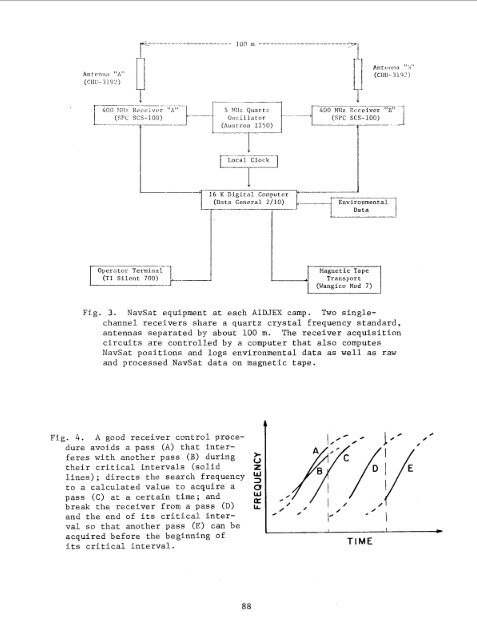AIDJEX Bulletin #40 - Polar Science Center - University of Washington
AIDJEX Bulletin #40 - Polar Science Center - University of Washington
AIDJEX Bulletin #40 - Polar Science Center - University of Washington
You also want an ePaper? Increase the reach of your titles
YUMPU automatically turns print PDFs into web optimized ePapers that Google loves.
~~<br />
Ant cmiiii "A"<br />
(CHU- 319 2 )<br />
c<br />
1 1<br />
400 tlilz Receiver "A"<br />
(SPC scs-100)<br />
1- 5 Nlz Quart/<br />
O\ciLlator<br />
(Ausi ron 1250)<br />
7---<br />
__t___l<br />
]a1 Clock 1<br />
--Ip-+<br />
Antc,nna "4"<br />
(CHU- 319 2 )<br />
400 Mltz Rrceiver "D"<br />
(SPC scs-100)<br />
I<br />
1.[-I6<br />
L<br />
I<br />
1<br />
K Digital Computer<br />
(Data General 2/10) 1 Environmental I<br />
I<br />
Transport<br />
(Mangico Mod 7)<br />
I<br />
Fig. 3. NavSat equipment at each <strong>AIDJEX</strong> camp. Two singlechannel<br />
receivers share a quartz crystal frequency standard,<br />
antennas separated by about 100 m. The receiver acquisition<br />
circuits are controlled by a computer that also computes<br />
NavSat positions and logs environmental data as well as raw<br />
and processed NavSat data on magnetic tape.<br />
Fig. 4. A good receiver control procedure<br />
avoids a pass (A) that interferes<br />
with another pass (B) during<br />
3<br />
their critical intervals (solid 2<br />
lines); directs the search frequency<br />
$<br />
to a calculated value to acquire a 0<br />
pass (c) at a certain time; and w<br />
a<br />
break the receiver from a pass (D)<br />
and the end <strong>of</strong> its critical interval<br />
so that another pass (E) can be<br />
~r,<br />
0<br />
I/<br />
I I +








